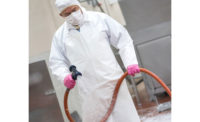Cleaning and sanitizing meat and poultry plants is no picnic. Workers typically sweat through the night in a wet environment while handling dangerous chemicals for what many perceive to be unsatisfactory wages.
It often results in high turnover rates, forcing many operators to perpetually recruit and train personnel to competently handle the range of sanitation requirements.
Yet, a number of producers seek to ease the strain by uploading sanitation to third parties, which analysts say is increasingly effective.
Deciding whether to use contract sanitation firms or stay with in-house personnel is a key issue for meat and poultry processors. While there are potential benefits for each, the optimal method depends on the needs of plants.
“At the end of the day, it is how best to meet a company’s list of sanitation requirements,” says Joe Allen, owner and president of Allen Safety LLC, an Orlando-based global safety and process improvement company. “Plant operators have to determine the items they are comfortable doing in-house, and those that are uncomfortable or will not be cost-effective to perform internally.”
Contract sanitation services have become more attractive because the vendors have strategies that enable them to provide more consistent and higher levels of service, he says.
That includes ensuring there are enough sanitation personnel to adequately clean each meat and poultry location within a given timeframe.
“Companies with just internal sanitation workers often struggle with high turnover rates,” Allen says. “Contract sanitation businesses, however, can transfer workers from one plant to another if there is an employee shortage at a particular location.”
Contract sanitation relieves producers of the strain of having to frequently hire and fire workers, he says.
“Plants that use contract sanitation are able to pass the staffing headache on to someone else,” says John Marcy, professor and extension specialist in the Department of Poultry Science at the University of Arkansas in Fayetteville. “Finding a contract cleaner with competent workers and that is dedicated to properly training the individuals may solve the staffing problem better than a processor could itself. The vendors are also often contracted to complete the sanitation job in a certain period and those that do not meet the obligation will pay a penalty.”
Meat and poultry processors in areas with shrinking labor pools are particularly ripe candidates for contract sanitation, says Martin Bucknavage, senior food safety extension associate in the Department of Food Science at Pennsylvania State University, in University Park.
“The shortage of workers is a constant challenge,” he says. “It is difficult to recruit and maintain staff, particularly because many companies have lower pay scales for sanitation employees than for operations personnel. Having continual turnover makes it difficult for workers to build up the expertise that plant operators need to ensure facilities are always in proper condition.”
While employing contract sanitation workers often can solve staffing and performance issues, processors cannot simply farm out sanitation and forget about it. Operators still need to conduct frequent audits of the third party’s processes, training and procedures, Allen says. Bucknavage agrees, stating that third-party sanitation becomes a collaborative effort.
“Sanitation needs to be managed regardless of who does it,” Bucknavage says. “It is critical that plants closely communicate with their contract sanitation companies and have a team approach in monitoring the effectiveness of the workers.”
Third-party contractors also can potentially handle tasks such as chemical ordering, chemical handling training, lock out/tag out procedures that are specific to sanitation, developing and annually reviewing cleaning methods, and assessing and purchasing personal protective equipment (PPE), Allen says.
“Some meat and poultry plants still do an amazing job with internal sanitation, but they may not want the hassle of dealing with it anymore,” he says. “It also can be less costly for third parties to handle sanitation due to better efficiencies from it being their core business.”
No end in sight
Regardless of how they leverage personnel for sanitation, operators still must ensure workers follow strategies that address the range of contamination threats, Marcy says.
“Sanitation is an everyday challenge and there is no quick fix,” he says. “It takes labor, time and money to do the job right as it is a hazardous endeavor that consists of many difficult tasks.”
Though performance and worker safety improve with the development of more effective chemicals and equipment, the cleaning process itself will always be demanding, he says.
“Sanitation crews tend to be shorthanded because the work is hard, difficult and dangerous, leading to a lot of turnover,” Marcy says. “I don’t expect it will ever get easy.”
The need to maintain sanitation crews that have the appropriate skills and motivation also will remain a critical element for both contraction sanitation vendors and meat and poultry plants, he says.
“The process won’t work well if a company just hires people, puts them in a wet suit and gives them a hose,” Marcy says. “You must have crews who have undergone the proper training and know what they are doing in order to be successful. Staffing is the key. Employing just anyone will always lead to trouble.”
To help stem turnover, plants and contract sanitation firms should focus on hiring personnel who are comfortable with, and might even prefer, working the third shift, he says.
“A lot of people don’t like working nights and are looking for the first opportunity to move to the day shift,” Marcy says. “You want to avoid those situations because it takes a lot of effort to keep training new employees. Sanitation training is severe and not simple for companies to conduct.”
Because working conditions can be brutal and the pay low, the best employees are those who find satisfaction in performing the job well, he says.
“They take pride in their accomplishments when it is done right and on time,” Marcy says. “Those workers also should be rewarded accordingly. It is not an unskilled job, but many companies mistakenly treat it as such.”
Performing when time is tight
Workers with ample sanitation experience also are highly preferable as they often can quickly adapt to changing operating circumstances. That includes being efficient enough to complete their jobs before the first shift is set to begin, even if the second shift runs late and condenses the allotted time for cleaning, Marcy says.
“It is difficult for a plant to postpone the start of the next day’s work because there are only so many hours in which to operate and it can cost a poultry operator more than $2,000 a minute when a production line is not moving,” he says. “Workers can’t clean a facility fully when production is underway and processors won’t stop the second shift just because it is behind schedule and the sanitation crew is ready to go.”
One critical sanitation requirement is locating the specific areas of plants and equipment that harbor pathogens or are ripe for generating bacteria, Bucknavage says, noting such spots are typically difficult to clean and/or prone to trap moisture or have water buildup.
Effectively containing such threats often requires the use of environmental monitoring programs in which workers take bacterial counts both before and after sanitizing, he says. Such procedures typically include swabbing a number of plant areas to measure pathogen levels. Workers can then get almost instantaneous readings with the use of ATP meters, which measure adenosine triphosphate, the molecule found in bacteria.
Once is never enough
“Personnel cannot just clean the difficult plant areas a single time and then believe that their cleaning is done for the day,” Bucknavage says. “There is always the need for a constant review, and that includes looking beyond the typical or major areas that they usually sanitize while also swabbing the most problematic areas more frequently. Programs need to evolve to where workers are always looking at potentially new sources of contamination.”
He notes problems can develop even with comprehensive cleanings, such as when moisture lodges in niches on rollers or conveyors, which can trigger contamination inside the equipment that then spreads to products.
“People are always looking for the magic bullet for successful sanitation, such as having the right cleaner or sanitizer, but it often is just a matter of workers doing a better job of finding the contamination points and responding accordingly,” Bucknavage says. “If there are high bacteria counts in some spots, operators need to investigate and put procedures in place to clean the areas better.”
While meat and poultry plant sanitation continues to evolve with the launch of more effective sanitizers, equipment and strategies, it is the expertise of the personnel who work for either contract sanitation firms or the producers themselves that will have the greatest impact on performance, he adds.
“It still is cleaning and sanitizing properly and making sure the workers are properly trained to do a good job,” Bucknavage says. “There always will be sanitation issues in plants regardless of how often workers clean the facilities. But while you can change the chemicals and equipment, it typically comes down to having personnel do the basics.” NP






Report Abusive Comment